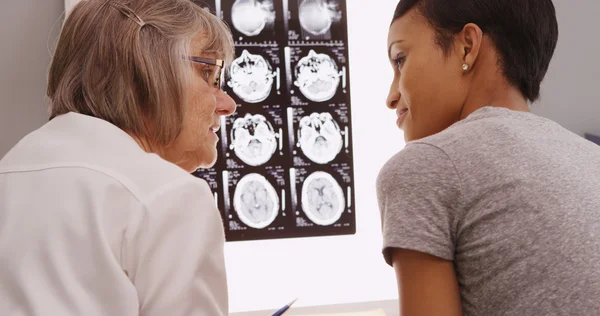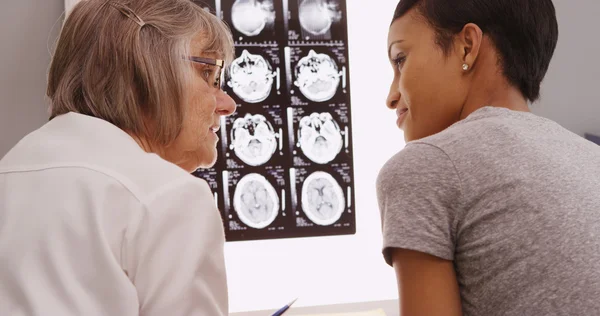Minimizing Unneeded Head CT Scans in the Elderly: A Promising New Guideline – As the number of elderly people rises, so does the frequency of visits to emergency departments by older adults who have experienced falls. Falls on the same level, such as those that happen at home, are a frequent reason for brain injuries. Although head computed tomography (CT) scans are commonly performed to evaluate patients after a fall, scanning every individual who falls is not only inefficient but also expensive.

Dr. Kerstin de Wit from Queen’s University in Kingston, Ontario, and her colleagues within the Network of Canadian Emergency Researchers discuss the negative aspects of excessive CT scanning in an article featured in the CMAJ (Canadian Medical Association Journal) [https://www.cmaj.ca/lookup/doi/10.1503/cmaj.230634].
Dr. de Wit points out, “The overuse of CT scans in this group not only extends the duration of the emergency department stay, increasing the chances of delirium but also takes away resources that could be used for other emergency patients. Additionally, not all emergency departments have access to CT scan facilities around the clock, which means some patients might need to be moved to another facility.”
To address this issue, a team of emergency department physicians from across Canada and the United States developed the Falls Decision Rule. This rule serves as a tool to identify patients who can safely forgo a head CT to rule out intracranial bleeding after a fall.
Read Related Also: The Importance of Early Detection: Identifying Red Flags for Heart Disease Symptoms and Possible Causes
The researchers included 4308 patients aged 65 years or older from 11 emergency departments in Canada and the US who visited the emergency department within 48 hours of falling. The median age was 83 years, 64% were female, 26% took anticoagulant medication, and 36% took antiplatelet medication, both of which increase the risk of bleeding.
The Falls Decision Rule, if implemented, could potentially eliminate the need for head CT scans in 20% of the study population. This rule can be applied to all older adults who have fallen, regardless of whether they sustained a head injury or can recall the fall.
This new rule complements the widely used Canadian CT Head rule, which is applicable to patients with disorientation, amnesia, or loss of consciousness.
The Falls Decision Rule has the potential to streamline emergency department care for older adults who have fallen, reducing unnecessary CT scans, minimizing resource utilization, and expediting patient flow.
Frequently Asked Questions (FAQs)
What is the main focus of the new decision rule for head CT scans?
The new decision rule is centered around reducing the number of unnecessary head CT (computed tomography) scans in older adults. This is achieved by assessing specific criteria that help determine whether a CT scan is genuinely needed, with the aim of minimizing unnecessary radiation exposure and maximizing the efficient use of medical resources.
Why is reducing unnecessary head CT scans important in older adults?
- Radiation Exposure: Older adults are more susceptible to the harmful effects of radiation. Reducing unnecessary scans lowers their risk of radiation-induced complications.
- Resource Utilization: CT scans are costly and resource-intensive. By minimizing unnecessary scans, healthcare facilities can allocate resources more effectively.
- Patient Safety: Unnecessary procedures can lead to unnecessary risks, including false positives that may result in additional unnecessary testing and anxiety.
How does the new decision rule work?
The rule incorporates a set of criteria based on the patient’s symptoms, history of trauma, and certain risk factors. Healthcare providers can use this information to make an informed decision about whether a head CT scan is necessary. The specifics of these criteria can vary, but they generally include considerations such as the severity of head injury, presence of certain symptoms (e.g., headache, vomiting), and patient history.
What are the expected benefits of implementing this decision rule?
- Increased Safety: By ensuring that only necessary scans are conducted, patients are spared from undue radiation exposure and its potential risks.
- Improved Efficiency: Healthcare providers can make quicker decisions about the need for head CT scans, leading to more efficient patient care and resource use.
- Cost Savings: Reducing the number of unnecessary CT scans can lead to significant savings for patients and healthcare systems alike.
Are there any risks involved in applying the new decision rule?
While the decision rule aims to reduce unnecessary scans, there is a risk of potentially missing injuries if the rule is too stringent or not applied correctly. It is crucial that healthcare providers are well-trained in applying the rule and that each decision is made considering the individual patient’s condition and history.
Can this decision rule be applied to all older adults?
The decision rule is designed for older adults but may not be appropriate for all patients in this age group. Factors such as the presence of specific medical conditions, the severity of symptoms, and individual patient histories may influence its applicability. It is essential for healthcare providers to consider these factors and use their clinical judgment in conjunction with the rule.
Is the new decision rule being used widely in healthcare settings?
The adoption of the new decision rule varies by healthcare facility and location. Some institutions may already be implementing it as part of their protocol for assessing the need for head CT scans in older adults, while others may be in the process of evaluating its efficacy and potential integration into their practices.






